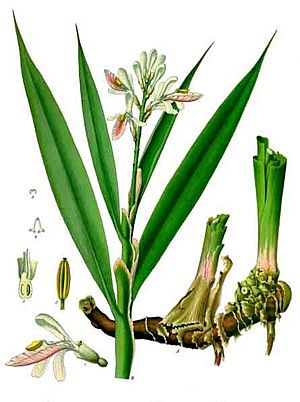Alpinia officinarum facts for kids
Quick facts for kids Alpinia officinarum |
|
|---|---|
 |
|
| Scientific classification | |
| Genus: |
Alpinia
|
| Species: |
officinarum
|
| Synonyms | |
|
Languas officinarum (Hance) P.H.Hô |
|
Alpinia officinarum, often called lesser galangal, is a plant that belongs to the ginger family. People grow it in Southeast Asia. This plant first came from China. It can grow quite tall, about 1.5 to 2 meters high. It has long leaves and flowers that are reddish-white. The underground stems, called galangal (or rhizomes), are very special. They have a sweet and spicy taste and a nice smell. People in Asia use them in dishes like curries and even in perfumes. Long ago, people in Europe also used them a lot. They are sometimes used as a traditional herbal remedy.
Contents
What's in a Name?
Where "Alpinia" Comes From
The name of the plant group, Alpinia, honors a person. It is named after Prospero Alpini. He was an Italian botanist from the 1600s. A botanist is a scientist who studies plants. Prospero Alpini was very interested in plants from faraway lands.
The Story of "Galangal"
The word "galangal" has a long history. It came from an Arabic word. That Arabic word itself came from a Chinese word for the plant. In Chinese, it is "高良薑". This sounds like "gou-loeng-goeng" in Cantonese. In Mandarin, it sounds like "gao-liang-jiang".
Galangal in Tamil
In the Tamil language, this plant is called "சிற்றரத்தை" or "சித்தரத்தை". This sounds like "see-tha-ra-thai". People in Tamil-speaking regions use it a lot. It is important in Siddha Medicine. It is also used in many local dishes.
Plant Description
How Lesser Galangal Looks
This plant is a type of herbaceous plant. This means it has soft stems, not woody ones like a tree. It can grow up to 2 meters tall. Its leaves are long and thin, shaped like a spear. This shape is called lanceolate.
Flowers and Rhizomes
The flowers of lesser galangal are white. They have streaks of red on them. These flowers grow from a spike at the very top of the plant. The most important part of the plant is its rhizomes. These are the underground stems. They are what people harvest and use.
The Special Rhizomes
The rhizomes of lesser galangal are thin and tough. They are the main reason this plant is grown. They have an orange inside and a brown skin. They smell very nice and have a sweet taste. These rhizomes are smaller than those of another plant, greater galangal. Greater galangal has a stronger, peppery taste. Lesser galangal's rhizomes are sweeter and less spicy.
How People Use Galangal
Galangal in the Past
Long ago, lesser galangal was very popular in Europe. This was during ancient and medieval times. People said it smelled like roses. They also thought it tasted like sweet spices. However, its use in Europe has greatly decreased over time.
Galangal in Asia
Today, lesser galangal is widely used in Asia. People often grind the rhizomes into a powder. This powder is then used in many dishes. It is a common ingredient in curries. It is also used in drinks and even in jellies.
Other Uses
In India, an extract from galangal is used to make perfumes. The Tatars, a group of people in parts of Asia and Europe, make a special tea with it. Lesser galangal also contains a natural chemical called flavonol. This specific flavonol is called galangin. Historically, people believed the rhizomes could help with digestion. They also thought it could act as a stimulant.
Where Galangal Grows
Lesser galangal originally comes from China. It grows mostly along the southeastern coast of China. This includes areas like Hainan. The plant is also grown in other countries. These include Japan, Thailand, and Vietnam. It is also cultivated in India. Hong Kong is a major place for buying and selling lesser galangal. It acts as a commercial hub for this spice.
Similar Plant Names
Sometimes, the name "lesser galangal" can be confusing. It is the correct name for Alpinia officinarum. However, people sometimes use it for other plants too.
- One such plant is Kaempferia galanga. This plant has a peppery, camphor-like taste. It is used in countries like Indonesia and Malaysia.
- Another plant, Cyperus longus, is sometimes called "galingal". It has spicy, starchy rhizomes that are also used in cooking.
- Boesenbergia rotunda is also sometimes called "lesser galangal". It is also known as Chinese ginger or fingerroot.
See also
 In Spanish: Alpinia officinarum para niños
In Spanish: Alpinia officinarum para niños

